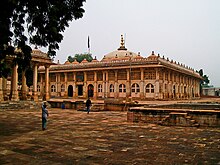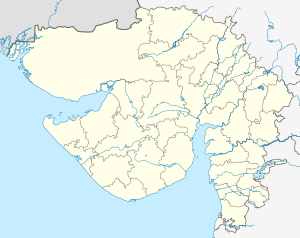Sarkhej Roza
| Sarkhej Roza | |
|---|---|

Ganj Baksh's tomb within the complex
|
|
| Basic information | |
| Location | Ahmedabad |
| Geographic coordinates | 22°59′32″N 72°30′16″E / 22.992136°N 72.504573°ECoordinates: 22°59′32″N 72°30′16″E / 22.992136°N 72.504573°E |
| Affiliation | Islam |
| Municipality | Ahmedabad Municipal Corporation |
| State | Gujarat |
| Country | India |
| Status | Active |
| Heritage designation | National Monument of Importance ASI Monument No. N-GJ-48 to 54 |
| Architectural description | |
| Architect(s) | Azam and Muazzam Khan |
| Architectural type | Tomb |
| Architectural style | Indo-Saracenic |
| Funded by | Gujarat Sultanate rulers |
| Groundbreaking | 1445 |
| Completed | 1451 |
Sarkhej Roza is a mosque and tomb complex located in the village of Makarba, 7 km south-west of Ahmedabad in Gujarat state, India. The complex is known as "Acropolis of Ahmedabad", due to 20th century architect Le Corbusier's famous comparison of this mosque's design to the Acropolis of Athens.
Although there are many rozas across Gujarat, the Sarkhej Roza is the most revered. Sarkhej was once a prominent centre of Sufi culture in the country, where influential Sufi saint Shaikh Ahmed Ganj Baksh lived. It was on the saint's suggestion that Sultan Ahmed Shah set up his capital on the banks of the Sabarmati, a few miles away from Sarkhej.
The architecture of the complex is credited to Azam and Muazzam Khan; two Persian brothers who are buried in the tomb near Vasna, Ahmedabad. The complex was originally spread over 72 acres, surrounded by elaborate gardens on all sides. Over time, human settlements came around it, eating into the gardens and reducing the area to 34 acres.
Shaikh Ahmed Khattu Ganj Bakhsh of Anhilwad Patan, the friend and adviser of Ahmed Shah I, retired to Sarkhej in his later life and died here in 1445. In his honour a tomb, begun in 1445 by Muhammad Shah II, was, in 1451, finished by his son Qutbuddin Ahmed Shah II. The next Sultan Mahmud Begada was fond of the place and expanded the complex greatly. He dug a large Sarkhej lake, surrounded it with cut stone steps, built on its south-west corner a splendid palace, and finally, opposite to the Ganj Baksh's tomb, raised a mausoleum for himself and his family, where he, his son Muzaffar II and his queen Rajbai are buried.
Entering the covered eastern gateway on the north bank of the Sarkhej lake, the building to the right with a handsome stone pavilion in front of it, is the mausoleum of Shaikh Ahmed Khattu Ganj Bakhsh. This, the largest of its kind in Gujarat, has along its whole length its sides filled with stone trellis work, and inside, round the tomb, has a beautifully cut open metal screen. Across the courtyard on the left are two mausoleums with a connecting porch, the east mausoleum containing the tombs of Mahmud Begada, and of his son Saltan Muzaffar ll, and the west, the tomb of Rajbai, Muzaffar's queen. Beyond the Ganj Bakhsh mausoleum is a courtyard, covering more than an acre of ground, surrounded by cloisters, with a mosque only slightly smaller than the Jama mosque. The want of minarets and the shallowness of its caves rather mar the outside effect. But inside 'it is the perfection of simple grace unrivalled in India except by the Moti mosque at Agra.' Looking across the lake the ruined buildings at the south-west corner are Mahmud Begada's palace and harem. The Sarkhej lake covers 17 acres. Oblong in shape, it is surrounded by flights of stone steps, and has a most richly decorated supply sluice.
...
Wikipedia

